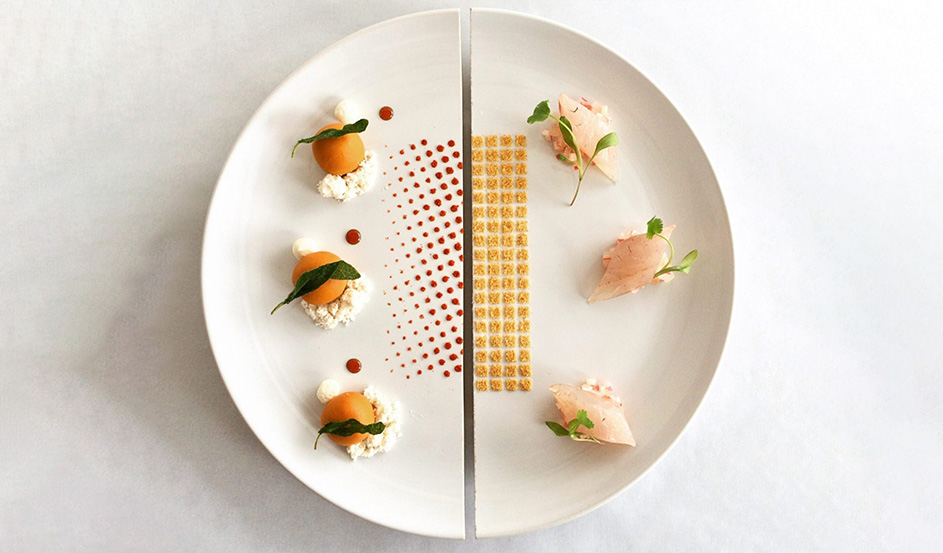
DEVELOPING A DISH – BOUBA & KIKI
Menu development and the creation of new dishes are among the most exciting parts of our work, when bringing a new concept to life we begin by developing a frame work which outlines the menu, service style, key ingredients & techniques, music, sensory cues and guest experience. By late last year we already knew we would have a dish titled Bouba & Kiki on the menu, and that the purpose of this dish was to demonstrate the non-arbitrary mapping between speech sounds and the visual shape of objects.
So what is the Bouba & Kiki? Well the idea behind this is really quite simple; take a look at the graphics below and decide which one is ‘bouba’ and which one is ‘kiki’.

Now if you see the more angular star like shape as being Kiki and the more rounded shape being Bouba you would be ‘correct’, or at least in line with the majority of the population. Fear not if you disagree – this is about perception, there are no right or wrong answers here.
These experiments were first conducted by the German gestalt psychologist Wolfgang Kohler and were repeated with the names “Kiki” and “Bouba” given to these shapes by VS Ramachandran and Edward Hubbard. In their experiments, they found a very strong inclination in their subjects to name the jagged shape Kiki and the rounded one Bouba. This happened with about 95-98 percent of the subjects. The experiments were repeated in Tamil speakers and then in babies of about 3 years of age (who could not write)…The results were similar. The only exceptions being in people having autistic disorders where the percentage reduced to only 60. The presence of these “synaesthesia-like mappings” suggest that this effect might be the neurological basis for sound symbolism, in which sounds are non-arbitrarily mapped to objects and events in the world.
It is also apparent from research conducted by Professor Spence’s Cross Modal Lab in Oxford that we have food related taste, flavour and textural associations with these shapes and the words bouba and kiki. So for example; place the following ingredients in either the bouba or kiki categories; sweet potato, creamy curd, paprika, rhubarb, lime, green apple. Now chances are the first three ingredients may appear more bouba(ish) to you, and the remaining 3 ingredients are more kiki(ish). The idea here being that the word bouba evokes the idea of more rounded, sweeter and fatty tastes, shapes and flavours, whereas the work kiki evokes more sharp, acidic, citrus-y, crisp, fresh flavours, tastes and shapes.
This all formed the basis upon which we developed this dish. So by now we had identified that we would need two parts to this dish, a bouba part which consisted of rounded, sweeter and fatty elements on the plate and a second half which represented kiki by using sharp, acidic, citrus-y, crisp, fresh elements. At this point a chefs intuition kicks in for which there is (so far) no scientific replacement. It is important for us at this stage to begin drafting and sketching out potential dishes based on the concept above while drawing heavily on our experience and knowledge of ingredients as chefs. We use all sorts of mind maps and diagrams linking ingredients based on several criteria; classic combinations (sometimes these just work and should not be discounted just because they are not entirely new; perhaps we can use traditional combinations which we deliver in a unique way right??), flavour pairings based on aroma compounds (this is an area I have my doubts about due to thresholds and volatility – along with a few other issues – none the less; leave no stone un-turned), and of course unique combinations we want to experiment with (based on our own perceptions and experience).
We also have to take into consideration factors such as flavour composition and balance within the dish (so looking at how to balance the sweetness, saltiness, sourness, bitterness and umami). Then one must bare in mind the somatosensory system – a complex sensory system made up of a number of different receptors responsible for processing sensory modalities, such as proprioception, mechanoreception (touch), thermoception (temperature), and nociception (pain). There are two cranial nerves that innervate the tongue and are used for taste: the facial nerve (cranial nerve VII) and the glossopharyngeal nerve (cranial nerve IX). The facial nerve innervates the anterior (front) two-thirds of the tongue and the glossopharyngeal nerve innervates that posterior (back) one-third part of the tongue. Another cranial nerve (the vagus nerve, X) carries taste information from the back part of the mouth. The cranial nerves carry taste information into the brain to a part of the brain stem called the nucleus of the solitary tract.
So now for the dish; after several concepts we decided upon the following flavour combinations:
Bouba: sweet potato, curd, pomegranate molasses, Parmesan oil, paprika and sage
Kiki: raw sea bass, lime, rhubarb, granny smith apples, vanilla and corn
Now the challenge was to find the right techniques and methods to deliver the ingredients while also conforming to the concept and most importantly developing pleasant and congruent textures (and temperatures). The bouba side has been developed as sweet potato dauphine with homemade curd, home made parmesan oil which we bulk with maltodextrin to form a parmesan powder, pomegranate molasses, fried sage leaves and paprika which we use to dust on the plate. Kiki became raw sea bass marinated in dulse soy sauce, served with brunoised apple and rhubarb which we dress with roasted vanilla and lime emulsion, in this case we used roasted corn which we blitzed down into a powder (the picture below shows the stenciling technique we have been playing around with).
Finally; I quickly wanted to mention the plating. Apart from correlating bouba with more rounded shapes and kiki with more angular shapes, I wanted the two parts of the dish to be one – but separate entities at the same time (make sense? probably not, sometimes these things only make sense to me and I have to find ways to communicate the message to my team in other ways!). So to accomplish this I decided on spiting the plate to create a clear distinction between the two elements while serving them as one. This sounds easier to accomplish than it was, but we finally managed to find a solution (see pics below!). As for service, I wanted the dish to be served with each half being placed before the guest by a separate server, so one half of the plate is set down and then the other half is set down beside it a few seconds later – this serves to reinforce the two identities within the dish.

And that’s just how we do it at KT 😉
Links:
https://faculty.washington.edu/chudler/tasty.html
http://en.wikipedia.org/wiki/Somatosensory_system
http://en.wikipedia.org/wiki/Bouba/kiki_effect



